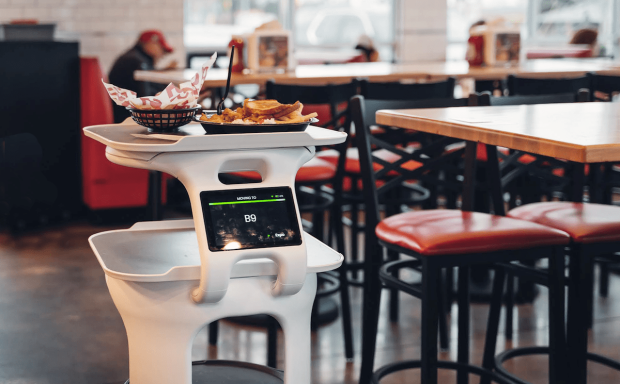Bear Robotics Announces $81M Series B as Restaurants Struggle to Meet Dining Demand

As restaurants’ labor challenges continue with no end in sight, demand is rising for robotic solutions to automate time- and work-intensive tasks.
Investors are taking note. On Tuesday (March 15), Bear Robotics, the Redwood City, California-based hospitality technology company behind “Servi,” a self-driving robotic waiter and busser, announced that it has raised $81 million in its Series B funding round, bringing the company’s total funding to $117 million.
“Having started my own restaurant years ago … I thought there must be a way to automate some of these repetitive tasks,” John Ha, Bear Robotics CEO and founder, said in a statement. “Servi [is] a solution meant to enhance the experience of customers, employees, and operators. While others are trying to fully automate work, we’re trying to elevate the future of work for stakeholders in this industry that keep it going each day.”
In an accompanying blog post, the company stated that these robots have made more than 28 million deliveries.
The company’s technology has been pilot tested at a number of popular restaurant chains. In November, a video went viral showing a Servi in operation at a Denny’s location. In October, news broke that Chili’s Grill & Bar, the Brinker International-owned casual dining giant with over 1,600 restaurants across 29 countries, was trialing a Bear Robotics server bot that the restaurant had dubbed “Rita” at 10 locations. Additional partners, the company stated in the blog post, include Marriott, Compass Group and Pepsi.
Read more: Restaurants Tapping Robot Servers Risk Repeating Past Mistakes
Robots Take Over Major Casual Dining Chains
In the aftermath of 2020, restaurants are left in a position wherein sales are higher than they were pre-pandemic even as their stores have fewer employees to meet this rising demand. U.S. Bureau of Labor Statistics data show that in February, the number of food services and drinking places (i.e., restaurant and bar) employees was up 14% from the same period 2021 and down just 7% from 2020.
However, according to U.S. Census Bureau data on advance monthly sales at food services and drinking places in January, the most recent month on record, seasonally adjusted bar and restaurant sales were up 27% over 2021 levels and up 9% from January 2020.
Part of this rise comes from the digital shift, with these off-premises orders not necessarily impacting what happens in restaurants’ dining rooms.
“Part of the labor shortage is … driven by digital orders, which grew tremendously during the pandemic and aren’t going away — so digital orders means that you can get many, many more orders instantaneously than you could ever get with a walk-in, a call-in, or a sit-down customer base,” Clayton Wood, chief executive officer at Picnic, told PYMNTS in an interview. “It’s an operational challenge … but it’s an opportunity for those who can get the right technology applied.”
Related news: Kitchen Automation Turns Digital Order Volume From Challenge To Opportunity
However, these areas are connected — if restaurants are forced to spend more on kitchen labor, it becomes harder to afford the wait staff to keep dining room operations flowing smoothly. Still, given that the hospitality element is core to table-service restaurants’ value prop, it remains to be seen how consumers will react as these sorts of technologies become more widespread.
